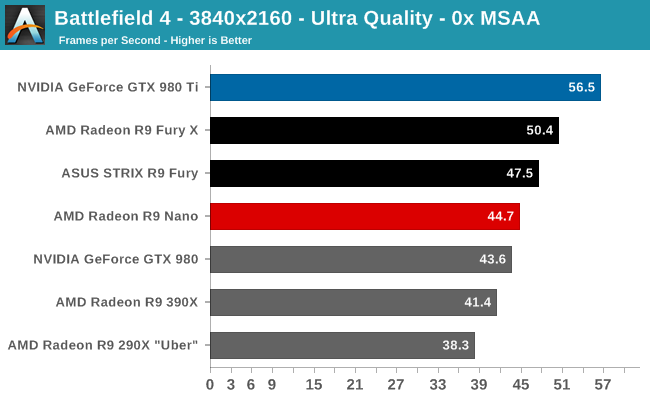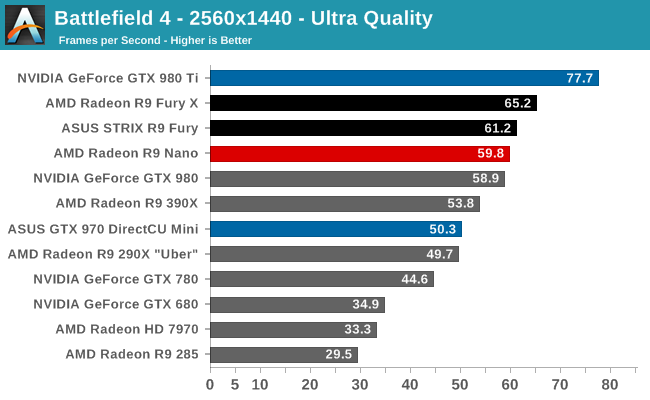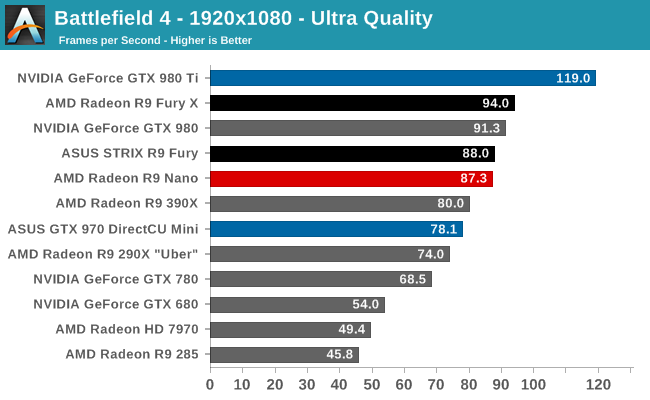The AMD Radeon R9 Nano Review: The Power of Size
by Ryan Smith on September 10, 2015 8:00 AM ESTBattlefield 4
Kicking off our benchmark suite is Battlefield 4, DICE’s 2013 multiplayer military shooter. After a rocky start, Battlefield 4 has since become a challenging game in its own right and a showcase title for low-level graphics APIs. As these benchmarks are from single player mode, based on our experiences our rule of thumb here is that multiplayer framerates will dip to half our single player framerates, which means a card needs to be able to average at least 60fps if it’s to be able to hold up in multiplayer.




Like the other Fiji cards, AMD is promoting the R9 Nano in part on its 4K capabilities. And while we disagree that this card is suitable for 4K gaming based on its sub-Fury performance, we’re including 4K results anyhow to serve as a point of comparison.
In any case Battlefield 4 is often a good indicator of general card performance, and for the R9 Nano this is no exception. What we find is that the R9 Nano trails the other Fury cards in all cases. However to our initial surprise, the R9 Nano sticks rather close to the R9 Fury. The petite powerhouse trails the R9 Fury by only 1-6%, which for the record is a smaller gap than we were expecting.
While the R9 Nano packs a full Fiji GPU, AMD has to pull back on clockspeeds to hit their power targets; in the case of Battlefield 4 this is an average clockspeed of just 879MHz at 2560x1440. Given this we had been expecting the R9 Nano to deliver around 85-90% of the performance of the R9 Fury (and about 80% of the R9 Fury X), based on the assumption that average clockspeeds would be closer to 800MHz. So the fact that the R9 Nano starts off as close to the R9 Fury as it does – even if it’s still trailing it – is a pleasant surprise.
Otherwise with performance still clearly occupying a position as a “3rd tier” Fiji card, I’m not sure if anything about these results should be surprising. On a price/performance basis AMD is not intending to be competitive with other $650 cards, so the R9 Fury X and GTX 980 Ti are of course on the top of the heap. What you get instead is a card that delivers around 90% of R9 Fury X’s performance in BF4 with much less power consumption.
Moving on, compared to the lower power and smaller cards, the R9 Nano is as expected a clean sweep. Demonstrating the virtues of a wide and lower clocked processor’s ability to deliver strong performance without requiring extreme power, everything from the R9 285 to the GTX 980 trails the R9 Nano here. Compared to the GTX 970 Mini in particular, the R9 Nano is 12-26% faster depending on the resolution.
The one potential problem here for the R9 Nano is the GTX 980. Though not a Mini-ITX card, the GTX 980’s power consumption is going to be fairly close to the R9 Nano’s, definitely more so than GTX 970’s. From a power efficiency standpoint it’s the GTX 980 that poses the greatest challenge to the R9 Nano, and while it’s ahead of the GTX 980 in this case at 2560x1440 and higher, it’s a sign that AMD should be worried about what could happen if an NVIDIA partner produced a Mini-ITX GTX 980.










284 Comments
View All Comments
Gigaplex - Thursday, September 10, 2015 - link
Because the Titan X is too big. This is a product that competes with the 970 mini in size (and efficiency to some extent) while being faster.RafaelHerschel - Thursday, September 10, 2015 - link
Because people like me build small systems. I do have a 'performance' system, but even that system isn't that big. A lot of energy means a lot of heat. There are quite a few practical reasons for smaller systems, but perhaps the most important one is that it seems silly to build a behemoth for a few extra frames per second.ThomasS31 - Thursday, September 10, 2015 - link
Yet, still if I could save $150 just for going a bit bigger case, or a different structured case, that can host longer cards... I would go with the latter as save money. :)My point in "positioning".
ThomasS31 - Thursday, September 10, 2015 - link
And ofc, I may get other benefits with that. Like not noisy like this (a good thing in a living room), and better temps.medi03 - Friday, September 11, 2015 - link
5% faster than gtx 980 at 65% of 980Ti price.mapesdhs - Monday, September 14, 2015 - link
The Nano and 980 Ti are the same price in the UK, with a particular model of 980 Ti being the far more sensible choice wrt performance.The Nano needs to be a lot cheaper to be worth bothering with. I'd rather use a larger case with a 980 Ti for the same cost, or a mini 970 since a product without HDMI 2.0 isn't suitable for 4K by default IMO.
Drumsticks - Thursday, September 10, 2015 - link
I kind of like the Nano. Small form factor stuff is always interesting to me.Also, is there any chance that we can get a directx12 preview of the fury and high end Nvidia cards? Given results other places were seeing for the 390x, I'm REALLY interested.
digitalgriffin - Thursday, September 10, 2015 - link
This makes ZERO sense. Why buy now for DX12 performance when a good crop DX12 games are at least 1, 2 years off? (Due to adoption of windows 10 and development time). You would be an idiot to buy now.Wait for the refresh in about 12 -> 18 months and AMD to get HBM2, fix the lack of ROPs and drop the DP FP support that adds a lot of unneeded transistors (my guess)...if they are still in business.
TheinsanegamerN - Thursday, September 10, 2015 - link
Not to mention, by the time DX12 becomes mainstream, these GPUs will be irrelevant. Like the first DX11 gpus, the geforce 400s. Sure, they work with modern DX11 titles, but they are too slow to be used in said games. nano, fury x, and maxwell will have the same issue.anubis44 - Thursday, September 10, 2015 - link
DX12 games are not 1-2 years off, they're imminent, since porting can be done pretty well directly to DX12 from consoles now. All that's required is Windows 10, and Steam is reporting Win10 already has a 17% adoption rate after only 1 month! At this rate, every gamer on Steam will be running Win10 by Christmas.